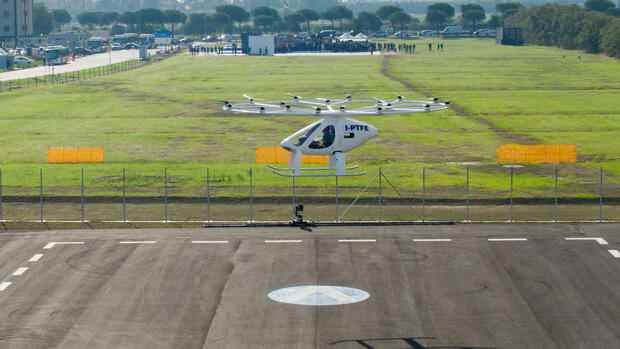From 2024 there will be commercial flights with passengers.
(Photo: dpa)
Rome Hardly anything can be heard when the 18 electric motors start up and the white vehicle lifts itself into the air. Much quieter than a helicopter, the air taxi hovers near Rome’s airport, makes a few laps and after five minutes lands back in the fenced concrete square, directly on a large “V” on the ground. The “V” stands for Vertiport, an infrastructure specially created for vertical aircraft.
The air taxis of the German start-up Volocopter have already flown all over the world: in Singapore, Helsinki, Seoul and Stuttgart. But here, at Rome Airport, the first landing strip at an airport was created. “This is an extraordinary milestone,” says Marco Troncone, head of the airport operator Aeroporti di Roma (ADR). They are completely on schedule: By 2024, Rome wants to be one of the first airports in Europe to put air taxis into commercial operation. Until then, one hopes for all official approvals.
In the coming months, further tests and experiments will be carried out here, and the landing pad will also be a kind of showroom for the public. But: The site is east of the terminal, from here it is an eight-minute bus ride to the airport building. The first vertiport directly at the terminal is therefore to be built as early as next year. The goal: It should take a maximum of five minutes from getting off the plane to the flight taxi.
Various routes are planned in Rome
The first route will lead to the center of Rome, which takes 20 minutes by air taxi. “We are now looking for routes on which the service makes sense and is worth the time,” explains Christian Bauer, CCO of Volocopter. He’s not only thinking of routes into the city center, but also of strategic locations outside, large commercial areas where many business people have to commute back and forth every day.
Top jobs of the day
Find the best jobs now and
be notified by email.
“It’s a misconception that air taxis will replace anything. They are an additional mobility offer.” The connection to an airport, with all the safety requirements and regular flight operations next door, is “the most difficult use case,” says Bauer.
“It’s a misconception that air taxis will replace anything. They are an additional mobility offer.” Christian Bauer, CCO of Volocopter
There has been a connection between Volocopter and Italy for a long time: the infrastructure holding company Atlantia, which also owns ADR and is majority-controlled by the sweater dynasty Benetton, invested 15 million euros in Volocopter two years ago. In the financing round in March of this year, Atlantia added another 35 million euros.
>> Read also: The ambitious plans of Benetton Holding Atlantia
Volocopter has an ambitious plan: Five to seven years after commercial approval, the company, which has not yet made a profit, wants to start mass production of its flying companions. And a mass production that was previously only known in the automotive industry. There will then be a two-seater, a four-seater and a cargo taxi.
Volocopter hit the headlines just this week because crowdfunding investors who gave money to the start-up nine years ago feel disadvantaged. The main argument is the interest on the loans at that time. The contracts were adhered to, emphasizes Volocopter CCO Bauer. “We are sorry that there were other expectations. It is also clear that there are disappointments about this.”
Benetton Holding Atlantia wants to roll out the concept across Europe
Atlantia wants to develop the concept of vertiports on an international level, also through the company Urban V, created by the airports of Rome, Venice, Nice and Bologna and which has built the first landing field. “The service will be cheaper than a helicopter,” emphasizes Carlo Tursi, head of Urban V. Thanks to more expensive batteries, prices will continue to fall in the future. He sees air taxis as part of a mobility network: “Perhaps you can cycle to the Vertiport, fly to the city center and from there take the tram for a few stops.”
The landing sites are all designed to be open to technology and can be approached by models from all providers. Tursi is also already thinking about joint ticket systems: When you buy a flight or train ticket, you could then book the air taxi at the same time. The security check could even be upstream on all Vertiports in order to save time at the airport. The operators are also in close contact with the Lazio region, to which Rome belongs, in order to set up vertiports directly at hospitals, for example. For example, organ deliveries could get from the airport to the patient much faster with a cargo air taxi.
More: Trouble at the air taxi company: 177 Volocopter investors are pushing for “fair participation”
